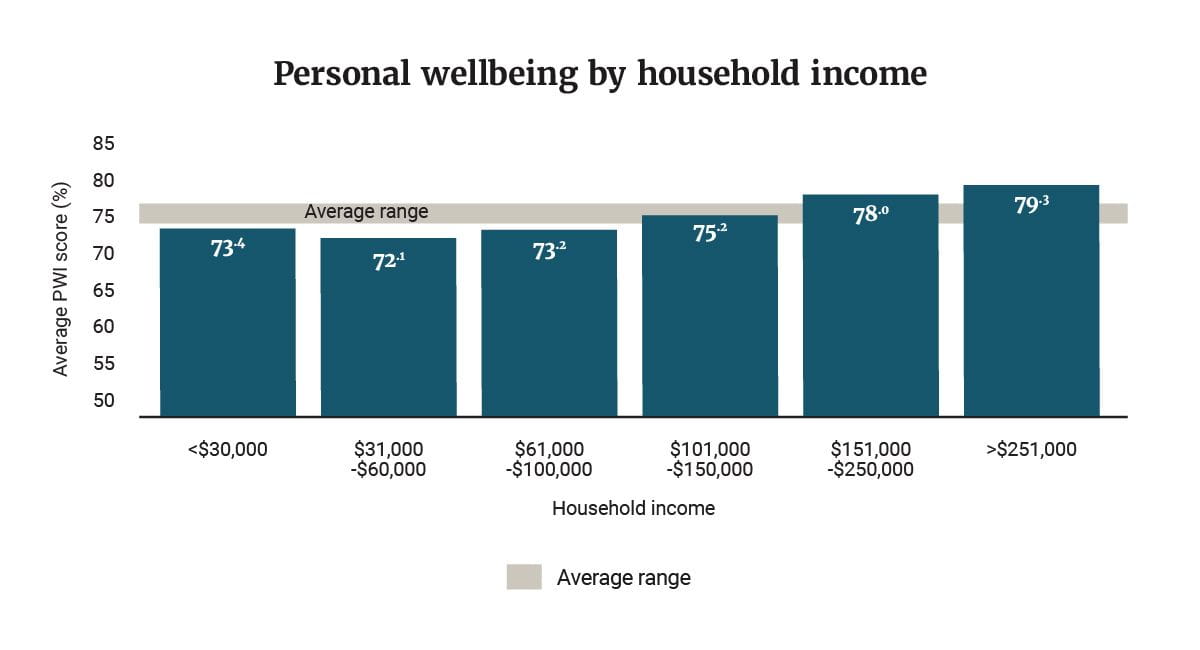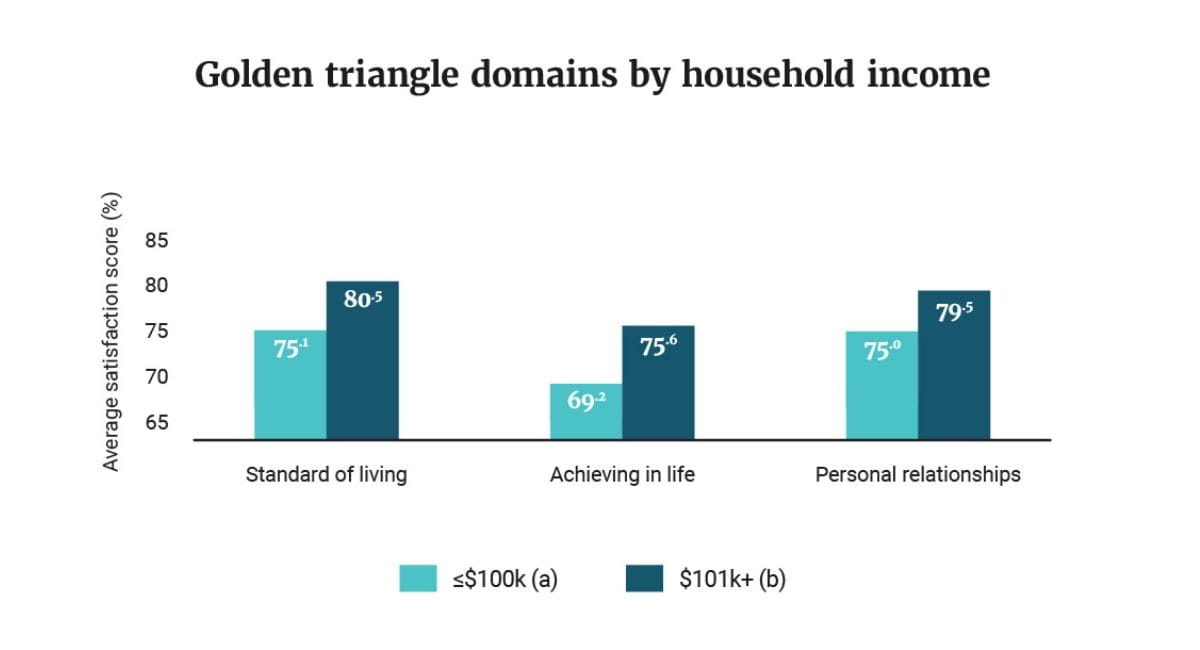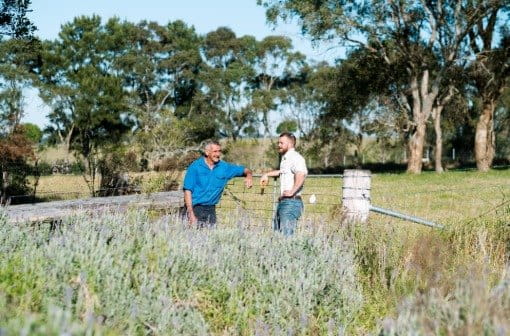"What we're seeing is that money matters more to personal wellbeing than ever before, as the cost of basic necessities rise.” —Dr Kate Lycett, Australian Unity Wellbeing Index lead researcher, Deakin University
Key points
- Previously, Australian Unity Wellbeing Index research found that people living in a household with income of less than $60,000 had their personal wellbeing most affected. In 2023, this group expanded to include households earning up to $100,000. With the median household income sitting at around $92,000, this cohort now encompasses more than 50 percent of Australian households.
- Conversely, the relationship between income and wellbeing, which previously weakened after $150,000 has shifted. The latest research reveals a large increase in the wellbeing of households earning over $101,000, and a bigger boost again for households earning above $150,000.
- Factors such as interest-rate rises, skyrocketing rents, increasing power bills and surging food costs are all having an impact, with many families and dual-income households needing support for the first time in their lives.
The Australian identity is centred on the idea that we live in an egalitarian society. We proudly celebrate the fact that we sit in the front seat of taxis and are far more likely to address someone as ''mate'' than ''sir''. Sadly, as a growing chasm emerges between Australia's "haves" and "have-nots", this long-held belief is starting to look like a glossy myth.

Income, wellbeing and the "everyday Australian"
Our financial situation is crucial to our wellbeing. The Australian Unity Wellbeing Index—a 22-year study into the wellbeing of Australians, conducted in partnership with Deakin University—shows a clear link between low income and lower levels of personal wellbeing, and past research has found that people managing on a household income of less than $60,000 had their personal wellbeing most affected. Over the past two years, however, that dial moved in an alarming direction.
“In 2023, all groups on a household income of $100,000 or less had personal wellbeing scores below the normal range,” says lead researcher Dr Kate Lycett from Deakin University’s School of Psychology. “So it's really significant to see that.”
The jump from $60,000 to $100,000 is concerning. According to ABS Census data, the median household income in Australia is around $92,000 per year. This means it's not just those on below-average finances whose wellbeing is low—it's the majority of Australians. “More than 50 percent of the population have a household income below $100,000,” says Kate.
It's a shift that has the potential to resonate throughout the lives of those affected. Wellbeing Index research has long identified the presence of a "golden triangle of happiness"—that is, three life areas that are the key to predicting overall life satisfaction. These are standard of living (financial wellbeing), achieving in life (a sense of purpose) and personal relationships.
This year's research showed an income-based divide in satisfaction with those areas. There were stark divides when it came to standard of living and achieving in life, where people with a household income of $100,000 or less were far less satisfied than people living in households earning more than $100,000.
"There's a pattern where people living on less than $100,000 had lower-to-average scores across those three areas," says Kate.
Sign up for wellbeing news
Get real wellbeing news, information and tips straight to your inbox.
A growing divide
A striking development is also visible in more prosperous households. Wellbeing Index research has traditionally found that wellbeing scores increase in line with income, but only up to $150,000. After reaching that threshold, the associated rise in wellbeing would normally be shown to plateau and level off. Now, Kate reveals, that relationship between income and wellbeing is continuing well into the higher wealth brackets.
“For households with incomes from $101,000 to $150,000, we’re now seeing a big increase in personal wellbeing, and that rise is repeated in the next group, which is $151,000 to $250,000. Once you get above that again, you get an even bigger boost," she says.
"What we're seeing is that money matters more to personal wellbeing than ever before, as the cost of basic necessities rise.”

Compounding financial pressures
The news that Australian households with incomes lower than $100,000 are struggling is grimly predictable for Ben McAlpine, Acting CEO of the NSW Council of Social Service (NCOSS). Earlier this year, when his organisation released a piece of research on the annual cost of living in NSW, the report’s name reflected this financial predicament. It was entitled Barely Hanging On.
“We've got the compounding effects of COVID-19, sky-high inflation, successive disasters, flatlining wages—all of these things are combining to push many towards breaking point,” explains Ben.
“We're seeing skyrocketing rents and month after month of interest-rate rises. That's causing more households to fall into housing stress. And as housing costs increase, that takes up more of a family's budget, so they need to either somehow earn more income or make increasingly difficult and fraught sacrifices.”

The impact on middle-income households
Esther Kerr, Australian Unity’s CEO of Wealth and Capital Markets, highlights the effect these pressures are having on households that previously would have been relatively financially stable. "What would have been a reasonably comfortable middle class in the past, is falling off the wellbeing cliff," she says. "One decent wage in a household isn't viable anymore. That's a canary we can't ignore."
NCOSS is also seeing widespread evidence of the pain this situation is wreaking on middle-income Australia. “Our members—critical frontline service providers—are seeing more families, including dual-income families who have never required support before, coming to seek help,” Ben says, pointing to rapidly increasing housing costs and the surging prices of everyday essentials—including power bills and food—as critical problems.
"These are issues that affect every single household. And while previously households on higher incomes were not being affected as significantly, we're now seeing that impact on households across the country.”
All this is concerning news for the notion of Australia being egalitarian and the country of the “the fair go”.
“The significant risk here is that as more and more people are pushed to the edge, they are only one financial crisis away from homelessness," emphasises Ben. "That is the type of ripple effect that could create significant gaps between the 'haves' and the 'have-nots'."
Disclaimer: Information provided in this article is of a general nature. Australian Unity accepts no responsibility for the accuracy of any of the opinions, advice, representations or information contained in this publication. Readers should rely on their own advice and enquiries in making decisions affecting their own health, wellbeing or interest. Interviewee titles and employer are cited as at the time of interview and may have changed since publication.
.jpg)

.jpeg)
